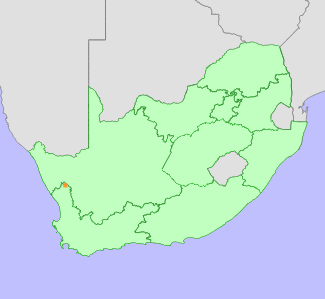|
Scientific Name | Conophytum buysianum A.R.Mitch. & S.A.Hammer subsp. politum A.J.Young & Rodgerson |
Higher Classification | Dicotyledons |
Family | AIZOACEAE |
National Status |
Status and Criteria | Critically Endangered A3d |
Assessment Date | 2021/11/16 |
Assessor(s) | A.J. Young, P.G. Desmet, I. Ebrahim, D. Guo, A. Harrower, L. Jabar, L. Knoetze, C. Rodgerson, P.C.V. Van Wyk & N.N. Mhlongo |
Justification | This succulent is endemic to the Northern Cape province of South Africa where it is only recorded from two subpopulations with an extent of occurrence (EOO) and area of occupancy (AOO) of 12 km². The dwarf succulents that comprise this genus have been increasingly targeted by illegal collection in recent years and the vast majority of species are in high demand by collectors. Whilst there is no evidence of illegal collection at the time of this submission, closely related species, including some from the immediate area, have been illegally removed from habitat with a dramatic increase in the number of species and volume of plants targeted since 2019. The threat of illegal collection is therefore regarded as very high for this particular subspecies given its limited geographic range and a complete decline of up to 100% of the population is possible within the next 10 years. Climate change is also impacting the population although there is uncertainty of the response given the expected resilience of this taxon. It therefore qualifies as Critically Endangered under criterion A3. |
Distribution |
Endemism | South African endemic |
Provincial distribution | Western Cape |
Range | This taxon is endemic to two locations in a small area of the Western Cape province of South Africa. |
Habitat and Ecology |
Major system | Terrestrial |
Major habitats | Namaqualand Klipkoppe Shrubland |
Description | This dwarf succulent is found in the Namaqualand Hardeveld bioregion of the Succulent Karoo biome. It primarily occupies a niche habit growing under the overhang of exfoliated granite slabs in partial shade. Some plants also grow in stable, shallow grit-filed depressions (pans) on weathered granite. This taxon has a generation length of 20 years. It is expected to be sensitive to the impacts of climate change as it does not disperse and while adapted to arid conditions, is dependent on limited seasonal rainfall. Species in the genus are sensitive to long periods of drought. Drought related mortality has been observed for other closely related taxa within the genus. |
Threats |
| Whilst there are no reports of illegal collection of plants of this taxon from habitat an extensive illegal trade for the ornamental succulent market in habitat-collected plants has developed since 2019, and includes many other species within this genus including closely related taxa. This particular succulent is difficult to cultivate and highly sought after so wild populations are considered to be at risk of illegal collection.
Anthropogenic climate change is a long-term threat to this taxon. While it is not possible to model the response of this taxon to climate change due to its restricted distribution, the average loss to climate change for 15 more widely distributed Conophytum species occurring within the same region is used as an indication of likely impact to this species. Climate models for the likely emission scenarios where emissions stay at present day levels (RCP 2.6) (Hausfather and Peters 2020) and worst case scenarios where emissions continue to increase during the 21st century (RCP 8.5) indicate that there will be a loss of suitable bioclimatic envelope of between 72% and 99% by 2080 for Conophytum taxa within the region. However, as this taxon typically occurs in a very sheltered habitat and possesses certain morphological traits likely to afford resilience to xerophytic conditions it is expected to have a level of resilience to climate change and the expected population loss is reduced by 20% to 52%. Species in this genus have limited dispersal ability and migration to suitable habitats elsewhere is regarded as highly unlikely. |
Population |
This is highly cryptic except when in flower making accurate estimates of population size extremely difficult. Based on field observations in the last 10 years the population size is estimated at no more than 2,500 mature individuals. The population is not known to be declining but future decline due to illegal collection for the ornamental succulent plant trade is highly probable.
|
Population trend | Decreasing |
Assessment History |
Taxon assessed |
Status and Criteria |
Citation/Red List version | | Conophytum buysianum A.R.Mitch. & S.A.Hammer subsp. politum A.J.Young & Rodgerson | EN B1ab(v)+2ab(v) | 2020.1 | | Conophytum buysianum A.R.Mitch. & S.A.Hammer subsp. politum A.J.Young & Rodgerson | VU D2 | 2017.1 | |
Bibliography |
Hammer, S. 2002. Dumpling and his wife: New view of the genus Conophytum. EAE Creative Colour, Norwich.
Hammer, S.A. 1993. The genus Conophytum: A conograph. Succulent Plant Publications, Pretoria.
Hausfather, Z. and Peters, G.P. 2020. Emissions - the 'business as usual' story is misleading. Nature 577(618-620).
Opel, M.R. 2004. The rediscovery of Crassula alcicornis. Haseltonia 10:38-40.
|
Citation |
| Young, A.J., Desmet, P.G., Ebrahim, I., Guo, D., Harrower, A., Jabar, L., Knoetze, L., Rodgerson, C., Van Wyk, P.C.V. & Mhlongo, N.N. 2021. Conophytum buysianum A.R.Mitch. & S.A.Hammer subsp. politum A.J.Young & Rodgerson. National Assessment: Red List of South African Plants version 2024.1. Accessed on 2025/11/07 |
 Comment on this assessment
Comment on this assessment

